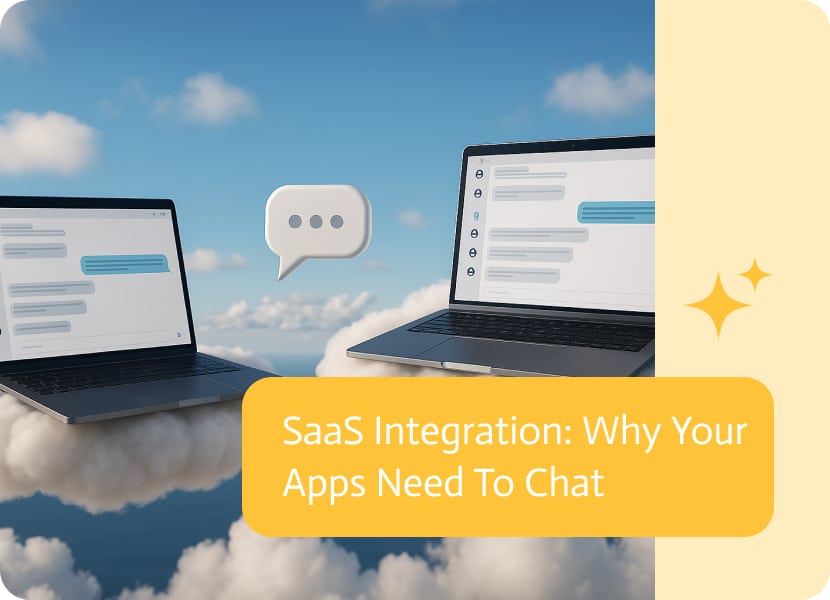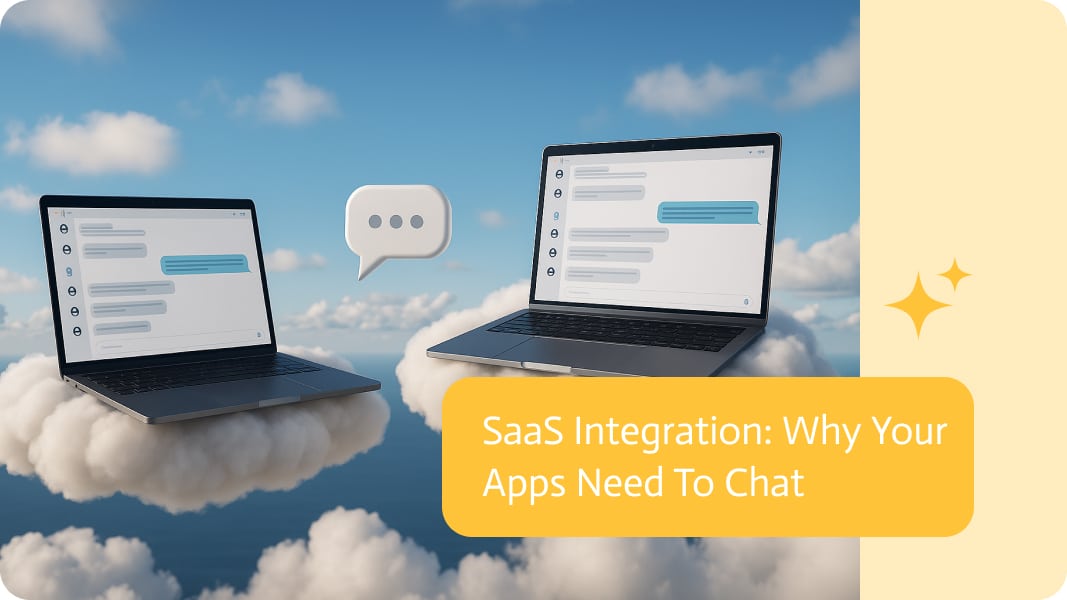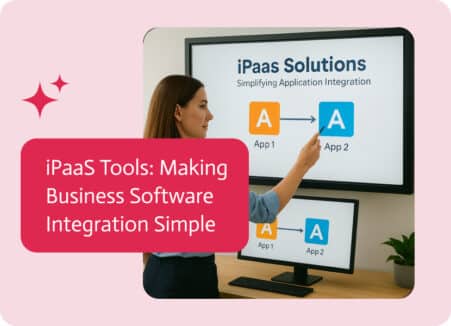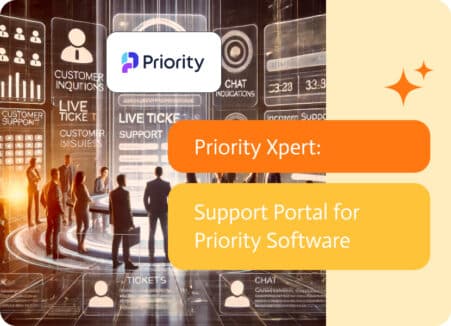

SaaS Integration: Why Your Apps Need To Chat
If you’re running a growing business, you’ve got a sales team firing off emails in HubSpot, your marketing crew building campaigns in Mailchimp, your support team is knee-deep in Zendesk tickets, and your finance folks are juggling invoices in QuickBooks. Everyone’s busy, everyone’s using tools they love, and none of those tools are talking to each other.
Welcome to the chaotic environment of unintegrated SaaS. A place where data goes to die, productivity slows to a crawl, and your team spends more time copy-pasting than doing real work.
This is where SaaS integration comes in. It’s not just the new craze that’s going to fade away, it’s how businesses these days keep themselves from falling apart.
So, What Exactly Is SaaS Integration?
SaaS (Software-as-a-Service) integration is the process of connecting your cloud-based apps so they can share information between themselves like mature adults. Instead of having to transfer data manually (or worse, yelling across the office), integrated systems pass information automatically and with lightning speed as well.
Imagine someone fills out a form on your website. Thanks to integrations, that person’s info can zip into your CRM, kick off an email sequence in your marketing tool, alert your sales team via Slack, start a to-do list in your PM app, all without anyone lifting a finger.
No duct tape. No Excel exports. No late-night coffee-fueled data cleanup.
How SaaS Integration Works (Without the Jargon)
At its core, SaaS integration helps your apps handshake and exchange data. This is often done using:
- APIs: Think of these as waiters taking orders between systems.
- Webhooks: These are essentially the ways your apps say, “Hey! Something just happened! Do something about it!”
- Middleware / Automation Tools: Platforms like Noca AI make connecting your tools super simple without needing to write any code at all.
Sometimes you’ll get lucky and your apps already come with “native” integrations, built-in connections to other popular tools. If not, you might need to DIY it or use an iPaaS (Integration Platform as a Service) to do the heavy lifting.
The Main Types of SaaS Integration
We’re all fully aware that trying to connect software applications the old-school way (think custom coding or those clunky point-to-point connections) is like a hit-and-hope clich’é. It’s time-consuming, rigid, and a drain on your budget. And as more companies embrace hybrid systems, multicloud setups, and an ever-growing pile of SaaS tools, these patchwork solutions just can’t keep up.
Here are some of the best ways to implement integration:
iPaaS
An Integration Platform as a Service (iPaaS) is both a translator and a broker at the same time. It assists with harmonizing disparate business applications by governing inter-application data transfer. The days of spending weeks in painstaking development are over. iPaaS brings order to chaos.
iPaaS offers a complete solution with an abundance of preconfigured connectors and templates that streamline the whole approach. And best of all, most iPaaS solutions come with some form of low-code or no-code functionality. So, whether you’re a developer or a business-oriented IT professional, you can effortlessly build workflows by dragging and dropping.
What is iPaaS capable of doing?
It goes above and beyond merely providing app connectivity and, instead, seeks to improve overall business processes. For example:
Syncing orders, inventory, and customers across your e-commerce store and CRM? Consider it done.
Automatically emailing invoices as soon as a project’s greenlight? Absolutely.
Alerting a support team when a system bug affects users? For sure.
It tackles the more tedious work, including confirming the delivery of data and maintaining compliance with data policies—the sort of work that would otherwise require a team of developers to do manually.
Innovative EiPaaS: Need a Hand with Integration?
A collection of cloud-based services dubbed Embedded Integration Platform as a Service, or EiPaaS, was created to link and integrate various sectors of an organization’s IT environment.
Eipaas refers to how the business purchases iPaaS and embeds it into the product. Therefore, a software company that sells software as a service (SaaS) would purchase a license from Noca to incorporate integrations through Noca without the users of the product being aware that Noca is managing the integration.
Practical Uses for Robotics: RPA
A new entrant in the picture now is Robotic Process Automation, RPA. RPA sounds like a concept from a sci-fi movie but it is simply about automating monotonous, repetitive tasks that human beings do not want to do.
Copying data from one application to another, updating spreadsheets, or dumping information into non-integrable systems are some of the things RPA can do in the SaaS environment. It is great for older legacy systems which were not designed with APIs in mind.
HR is a great case to use. An RPA robot can take over monotonous tasks such as entering a new hire’s details into multiple systems. The “robot” can perform record updates, onboarding emails, and IT access requests. Just keep in mind, if your applications undergo a UI overhaul, the bots might require some upkeep in order to avoid maintenance issues.
Custom Integrations: The Cautious DIY Approach
At times, rolling up your sleeves and building something proves to be the best solution. This especially applies to combining multiple systems or applications through custom or native integrations. These are the sorts of integrations crafted specifically by your developers to address a unique need, especially where pre-packaged offerings don’t suffice.
If all you require is a couple of integrations and know exactly what you want, custom works fine. However, having dozens of systems and applications to a mix can turn a singular DIY approach into a costly web. The task becomes time-intensive and near impossible to scale. On top of that, constant updates mean needing to recode and re-test. This process can be compared to renovating your entire kitchen every single time you buy a new appliance.
So, What’s the Best Path Forward?
In today’s fast-moving tech landscape, integrations aren’t a nice-to-have—they’re essential. Whether you go with an iPaaS platform to handle it all from a central hub, use embedded tools built right into your SaaS apps, automate the grind with RPA, or go full-on custom, the key is choosing what fits your company’s complexity and future plans.
Just keep in mind that integration doesn’t have to be unpleasant. You can simplify the way you work, reduce the amount of labor required, and eventually get your apps to interact with other apps without losing your mind if you have the proper equipment and a well-thought-out plan.
Why Does It Help So Much?
Let’s unpack why SaaS integration isn’t just “nice to have.”
1. No More Copy-Pasting
Entering data manually in the 21st century is the equivalent of shovelling coal into a steam engine. Integration automates this. Now you can pay attention to expanding, not babysitting spreadsheets.
2. Your Team Actually Knows What’s Going On
With everything connected, your salespeople see customer support tickets. Your marketers see real-time lead activity. Everyone gets the same story, not ten different versions.
3. Things Move Faster. Way Faster.
Workflows run like clockwork. Getting a new hire means their accounts get created automatically, they get added to Slack, and their onboarding docs get sent out. No bottlenecks or lag.
4. It Costs Less Than Screwing Up
Yes, there may be some up-front setup time. But integrated systems reduce errors, save employee time, and scale way better than hiring more people to do tasks robots could handle.
5. Customers Notice (and Appreciate It)
When your tools are talking, your service becomes lightning-fast and creepily personalized, but in a good way. Customers will automatically feel like you “get them” because your systems actually do.
SaaS Integration In The Real World
Let’s say you’re running a small e-commerce brand:
- Orders come in through Shopify.
- Your email sequences are handled by Klaviyo.
- You track inventory in Airtable.
- Customer service runs through Gorgias.
- Finance lives in Xero.
Unintegrated, this setup is nothing short of a hot mess. You’re dragging CSVs between apps, bouncing between tabs, and praying you didn’t forget to update inventory before your next product launch.
With integrations? New orders update inventory, send confirmation emails, notify your support team, and automatically reconcile with your accounting software. Let’s be straight: it’s not just very convenient, it’s operational freedom.
Food For Thought
APIs can be a bit flaky.
They change and get deprecated or go offline without even letting you know. If you’re not on top of the tabs, that cool integration you set up last quarter might suddenly stop working like a moody printer. Maintenance and good version control can help everything run as it should, streamlined.
Not every app wants to be friends.
Some tools just aren’t built to talk to others, or they talk in weird, outdated dialects. You might need to bribe them with middleware or translators (aka third-party tools or custom code) just to get a basic handshake going.
Garbage in, garbage out.
If your data is messy going into an integration, it’ll be even messier coming out the other side. Syncing bad data across systems is like photocopying a smudge, you just spread the chaos around.
Security shouldn’t be taken lightly.
Anytime you’re plugging in sensitive systems without proper encryption, authentication, or access controls, it’s always risky business. Always make sure your connections are safe and that you’re not accidentally sharing the company vault with a rogue spreadsheet.
No need to panic.
These issues aren’t deal-breakers. They’re just the fine print of building in the real world. With some planning, the use of proper tools, and, of course, a touch of common sense, you can avoid the worst of the pitfalls. And let’s be honest, it still beats manually copying data between 17 tabs while crying into your keyboard.
Final Thoughts
SaaS integration isn’t about buying more software. It’s about getting more out of the software you already have. It’s the difference between tools working for you vs. tools working against each other.
In the 21st century, almost every business runs on a stack of 10, 20, or maybe even 50+ cloud apps, integration is what keeps everything humming, like an orchestra instead of a room full of toddlers with tambourines. Want help getting started with integrations? Start small. Connect your CRM to your email tool. Automate your invoicing. Watch what happens when your team stops playing digital whack-a-mole and starts working like they’ve got superpowers. You’ll wonder why you ever did it the hard way.


